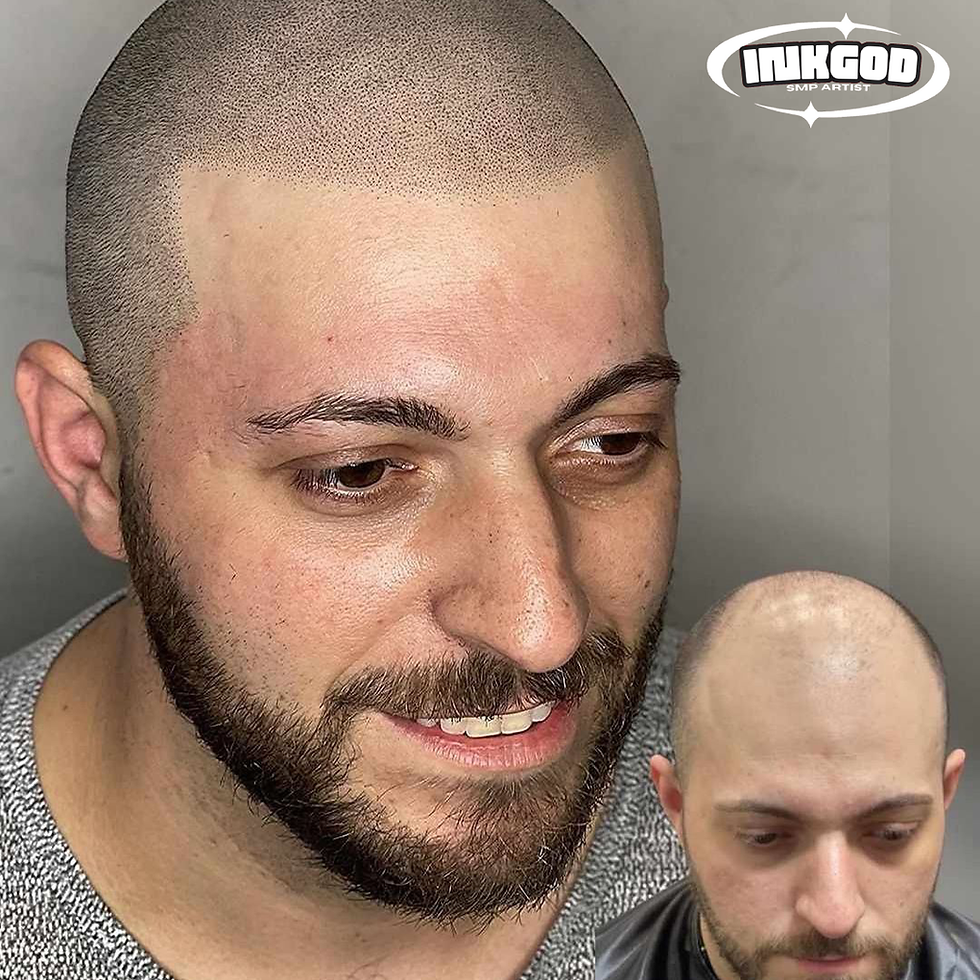SMP on Dark Skin Tones in New York: Color Theory, Pigment Choice, Aftercare
- Dmitry Semykin
- Aug 31
- 3 min read
Updated: Sep 1

Dark skin looks amazing with a clean buzz finish or a quiet density fill. The key is tone. If the tone heals right, the whole result looks natural. Let’s keep it simple and move step by step, from color theory to aftercare, so each part sets up the next.
Color theory in one minute
Melanin adds depth and warmth. Under that depth you still have undertones. Some people run warm and golden. Some lean red or cool. We match the healed look to those undertones. If we go too cool, the scalp can look ashy. If we go too warm, it can read muddy. Balance is the target.
Once we understand your undertone, we can choose a pigment that heals neutral on your skin instead of fighting it.
Pigment choice that heals clean
For dark skin, a neutral to slightly warm charcoal usually heals best. Pure blue-black can heal cold and ashy. True brown can heal too warm. We test a tiny swatch in a hidden spot and check it in natural light. No guesswork.
Viscosity matters too. A thinner carrier can spread too fast in very oily skin. A steadier carrier sits cleaner. When the carrier suits your skin, dot edges stay crisp, which sets up the next decision.
Needle size and dot control
Dot size has to match your shaved hair caliber. On dark skin, contrast is higher, so oversized dots pop more. We use small groupings, light pressure, and short dwell time. That keeps dots tight and soft after healing.
Controlled spacing is next. If spacing is too close, the area looks painted. If spacing is too wide, the scalp reads empty. We place a breathable pattern that blends with your side hair and sets the stage for hairline work.
Hairline design that fits the face
Sharp straight lines can look fake on any skin tone. On darker skin they can look stamped. We keep edges soft and slightly irregular. Temple flow matters. We follow your natural growth pattern and let the hairline fade into side hair. The design becomes the map for session two, where density comes alive.
Sessions and pacing
Most clients do two to three visits.
Session one lays the foundation and sets the tone.
Session two builds density and blends.
Session three is for micro-adjustments if you want extra polish.
We let skin rest between sessions so the color settles. That rest leads into aftercare.
Aftercare for dark skin tones
Early aftercare protects edge sharpness. Later care protects tone.
Days 0 to 3 Keep the scalp dry and cool. No gym. No steam. No sun. Do not pick. Sleep on a clean pillowcase.
Days 4 to 7 Light cleansing with lukewarm water. Pat dry. If you feel tightness, a tiny amount of neutral moisturizer is fine. No heavy oils.
Week 2 Back to normal showers. Gentle shampoo only. Start daily SPF if you go outside. SPF is a must on dark skin too. It keeps the tone from shifting.
Ongoing SPF. Hats for long sun days. Avoid harsh exfoliants on the treated area. If you shave, use a fresh blade and light pressure. Keep the look even with a regular shave schedule.
Common worries and how we handle them
Ashy or grey look Comes from too cool a tone or over-saturation. We pick neutral pigment, keep dots small, and layer slowly.
Blurry dots Often a mix of too deep, too slow, or very oily skin. We adjust depth, technique, and carrier.
Shine Dark skin can reflect studio lights. Matte SPF or a light mattifying lotion solves it.
Keloid history If you have a known keloid tendency, tell me upfront. We can patch test and adjust the plan, or coordinate with your dermatologist.
What realistic results look like
Fresh work looks a touch darker and red. In a few days redness fades. In two to four weeks tone softens. On darker skin the final look should be soft charcoal, not blue and not brown. You get a clean buzz look or quiet density that disappears into your side hair in daylight. That is the goal we design for in session one and refine in session two.
Maintenance and touch-ups
Expect a light refresh in two to four years. Sun speeds fading. SPF slows it. Touch-ups are quick because the map already exists. We only restore micro-contrast. If you are looking to get your SMP done, book a free consultation call to see if you qualify for SMP: https://www.inkgodsmp.com/consultation Also read SMP Cost in NYC: Pricing, Sessions, and What Affects It




Comments